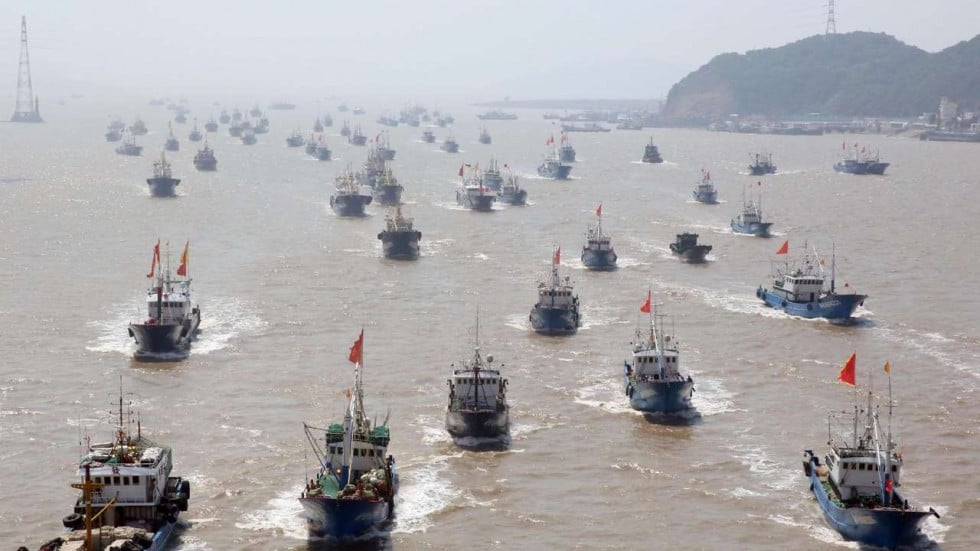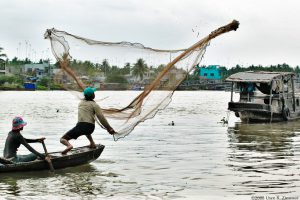Chinese and English-language media outlets have recently reported on how the collapse of local fish stocks off China’s coast is inflaming disputes over maritime territories between China and neighbouring states as the Chinese fishing fleet ventures into more distant waters in search of more productive fishing grounds.
From Asia’s coast, to Africa’s
Stagnant catches in China’s domestic waters, plus state subsidies for the fishing industry, drive investment in bigger boats that venture farther afield in search of fish. Fishermen in the Zhoushan Archipelago, the island chain off of Zhejiang and Jiangsu provinces that is one of China’s largest fishing centres, claim that overfishing and pollution off of China’s coast have pushed boats farther afield.
Species such as yellow croaker (黄鱼) and cuttlefish (乌贼) can no longer be caught in commercially viable amounts in Chinese coastal waters. The need to catch fish has necessitated a stronger international stance, increasing Chinese fishing pressure in waters claimed by other states. “If the country wasn’t subsidizing the diesel, half the boats would be off the water,” noted one boat owner in Zhoushan. “But fishermen need to fish. If there aren’t fish in our waters, we need to go elsewhere.”
China’s long-distance trawlers operating illegally off the coast of Guinea have depleted fish populations off the west coast of Africa as they search for yellow croaker, which Guinean fishermen too know to be “the most prized fish in Asia”. The yellow croaker, now classified as severely depleted, has all but disappeared from Chinese waters because of overfishing.

But this is hardly the first time that mounting pressure on yellow croakers and other fish stocks has caused territorial disputes between China and its neighbours, though China’s role in earlier disputes was rather different. As early as the 1920s and 1930s, Chinese fishers’ abandonment of near-shore waters in favour of fishing grounds in more distant waters and the Japanese mechanized fleet’s exhaustion of marine resources in the East China Sea also brought them into competition for yellow croaker fishing grounds off the Zhoushan islands.
Chinese and Japanese competition over the yellow croaker
During the late nineteenth and early twentieth centuries, Chinese fishing boats in Zhoushan harvested yellow croaker in waters relatively close to the mainland. This situation began to change as the lure of previously unexploited stocks attracted the Chinese fleet, which consisted of sail-powered junks, to waters over one hundred nautical miles from the archipelago’s most distant islands.
According to a record of Zhoushan’s fishing industry from 1920, “Those who have been involved in the fishing industry for a long time say that thirty or forty years ago large yellow croakers followed the tides and came to islands close to shore. At that time, there were not many boats, their fishing methods were crude, and catching fish was relatively easy. Now the number of fishing boats has increased, fishing gear is better, and the fish hide in the deep waters.” As greater yields from nearshore fishing grounds fell, Chinese fishing boats expanded into more distant waters to maintain their catch rates and to try to turn a profit.
Meanwhile, on the other side of the East China Sea, Japan’s fishing industry was already transforming the marine environment on a far more massive scale. At the end of the nineteenth century, Japan launched a successful modernization program to break into the ranks of the world’s imperialist powers. From the 1890s into the early 1900s, Japan used this industrial and military capacity to extend its hold over Taiwan, and Korea, as well as parts of Manchuria and north China. The development of Japan’s fishing industry went hand in hand with the nation’s industrialization efforts at home and imperialist expansion abroad.
Strengthening the nation’s sea power by securing a greater share of the world’s marine resources motivated the growth of Japan’s fisheries. Technological modernization began with the introduction of steam-powered fishing boats from Europe to Japan, which spread rapidly during the Meiji era (1868-1912). At first, Japan’s mechanized fishing vessels ranged across the East China Sea and Yellow Sea to catch bream and other high-priced species, but overfishing soon led to their depletion.

During the 1920s, catches of bream declined, while yellow croaker (which Japanese previously considered a low quality species suitable for processed fish products) took their place. Hence, during the early 1920s Japan’s mechanized fleet moved into waters off the Zhoushan islands where yellow croaker spawned during the spring and early summer. Japan’s government encouraged this shift by granting subsidies to enterprises engaged in pelagic fisheries and fishing in foreign waters.
As the Japanese fleet targeted fishing grounds off the Zhoushan islands, it came face to face with Chinese fishing junks that had ventured into offshore fishing grounds during the early twentieth century, sparking a series of international disputes.
Conflict beyond the three mile zone
Faced with foreign competition, Chinese fishing enterprises urged China’s Nationalist government to exclude technologically superior Japanese vessels from its coastal waters. Yet Chinese fishing boats had already ventured well beyond the three-mile territorial limit that Japan and China adhered to during the 1920s and 1930s.
Japanese fishing activities off the coast of China were clearly indicative of the larger pattern of aggression – driven by Japanese imperial ambitions and colonial impulses – that characterized Japan’s relations with China during the early twentieth century.
Given the unequal power relations that existed between China and Japan at the time, the Chinese government could not risk trying to extend their territorial claims. China’s leaders employed other tactics to keep Japanese-caught fish out of Chinese markets, but Japan’s position of diplomatic advantage and military strength vis-à-vis China rendered their efforts ineffective.
These transformations of the marine environment intensified diplomatic tensions as well as processes of environmental change. A transnational race to exploit the marine environment, in which technological superiority and military advantage gave the Japanese the decisive upper hand, led to a decline in the productivity of yellow croaker stocks by the mid-1930s.
Fishing as a form of national power
Although modern technology made it possible for Japan’s fishing fleet to deplete marine life on a much larger scale, Chinese and Japanese participants in these disputes all understood fisheries as a vital means of fortifying national wealth and power. Even as Japanese vessels placed ever greater and greater demands on yellow croaker stocks, the Chinese government advocated fishery development policies that were intended to counter foreign competition by increasing domestic production and consolidating China’s maritime power.
Like their Japanese counterparts, Nationalist China’s leaders viewed the control of the ocean and its resources as a crucial way of promoting national strength and economic development. The preservation of the yellow croakers did not enter into the equation.
This conception of the marine environment, already prevalent during the early twentieth century, might help explain the vigour with which China’s fishing fleet has followed Japan’s lead by exploiting fish stocks in waters claimed by other countries in recent years.
Micah Muscolino is Jessica Rawson Fellow & Tutor in Modern Asian History at Merton College and Professor of Modern Chinese History at the University of Oxford. His most recent book, The Ecology of War in China: Henan Province, the Yellow River, and Beyond, was published by Cambridge University Press in 2015.
This story is told in much greater detail in Micah S. Muscolino, Fishing Wars and Environmental Change in Late Imperial and Modern China (Cambridge, Mass.: Harvard University Asia Center and Harvard University Press, 2009) [Chinese translation: 穆盛博《近代中国的渔业战争和环境变化》译者: 胡文亮 (江苏人民出版社, 2015)], as well as Micah Muscolino, “The Yellow Croaker War: Fishery Disputes between China and Japan,” Environmental History 12 (April 2008): 305-324.







